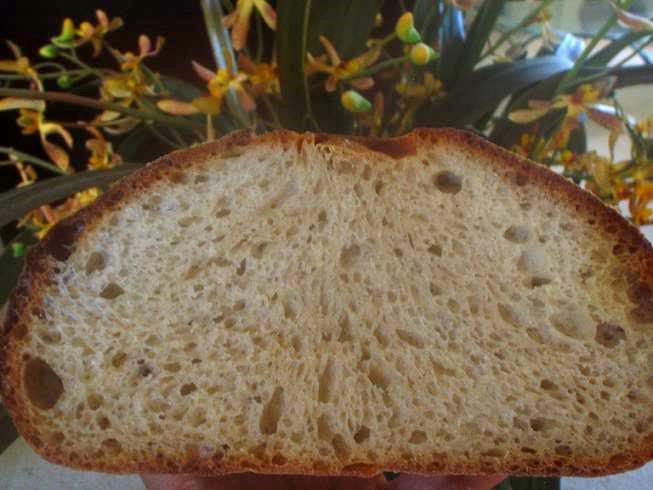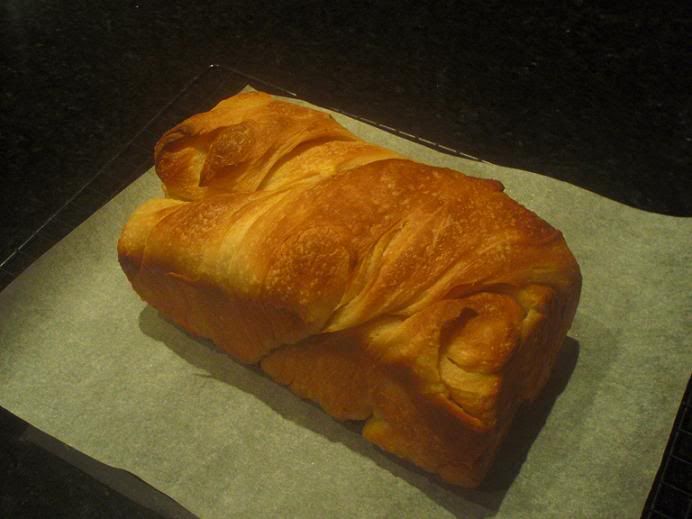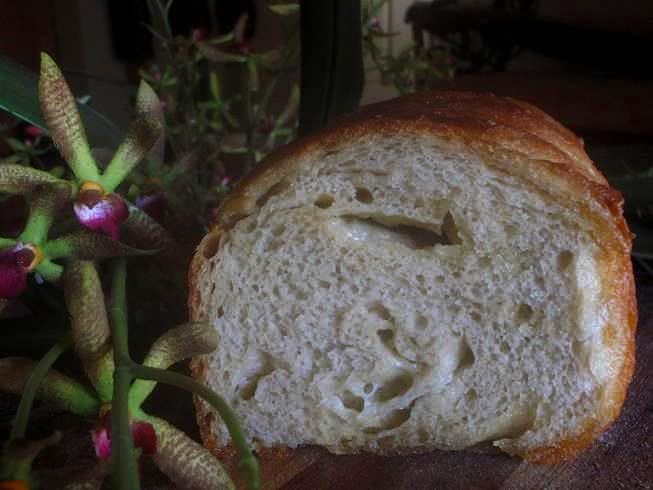The method of these two sourdough breads came from Bolangerie Comme Chinois' head chef, Nishikawa Takaaki, in Kobe, Japan. His most recent cook, "Varie" (i.e., variety breads) is one of the most amazing books of modern French breads I have ever read. For over many decades Japan has had dedicated chefs working and training in France; they then went back to Japan to not only spread the French bread culture but also to enrich their own. The breads and pastry shops in Japan are simply wonderful. In 2002 Japan won the triennial Coupe du Monde de la Boulangerie in Paris. (The US team took gold in 2005 and France only reclaimed their home gold in 2008. Incidentally, Taiwan's first-ever representation to this event in 2008 came second to hosts France.)
As Taiwan was under Japanese occupation for 50 years which ended at the end of the Second World War, many of my parents' generation speak Japanese. I grew up in Taiwan eating what I now know as "variety breads" from Japan, which in turn came from France but with a heavy Japanese influence. The "variety breads" that I had as a young kid were, and still are today, a meal on its own. They can be either savory or more desert like - anything is possible with these variety breads.
All variety breads came from a basic dough piece with "variety" built on to it. Before I tried anything fancy, I thought I'd start off plain. I used Nishikawa Takaaki's Pain Paysanne recipe for both breads here, which has 15% whole wheat and 5% rye meal. It employs a poolish as well as a very firm starter @ 49% hydration. My basic dough weighed 1,250g at 65% hydration, 700g of which I used for the plain sourdough bread below, and the balance 550g for the "wave" loaf. For the sourdough bread, it's bulk fermented for 50 minutes at 28 degree C (82F) with one stretch & fold at the 30 minutes mark, then shaped and proofed for 3 hours also at 28 degree C.

plain sourdough bread using Nishikawa's Pain Paysanne recipe

My "wave" loaf below is a poor representation of Nishikawa Takaaki's version. The basic dough is placed in freezer for 30 minutes to firm up, at which point a piece of flatten out butter (25% dough weight) is incorporated and folded several times - much like the way dough is prepared for croissant. The dough is then divided into two pieces which are twisted and, at the same time, braided before being placed into a loaf tin to proof for 3 hours at 28 degree C (82.5F), then bake with steam.

sourdough "wave" loaf using Nishkawa's Pain Paysanne's recipe as the basic dough

Shiao-Ping
- Shiao-Ping's Blog
- Log in or register to post comments
Wow, Shiao-Ping, you've done a beautiful "wave" that looks so delicious, buttery and crispy! If that's a poor loaf..... then I'm dumbfounded! The Sourdough looks classic and has wonderful crumb structure. When can I come and take classes from you?
Is there yeast in the poolish contributing to the short bulk rise times? I add up about 4 hours of rising for each loaf is that correct?
Mini
These breads are just gorgeous, Shiao-Ping! The plain pain paysan has a beautiful allure, it looks like a work of art. As for the wave bread, I have never seen anything like it. I might not go for that particular formula (I am not a butter person) but I love the styling of it. Do you know if that book Varie has been translated into English (or French)?
Meanwhile I also notice that the rising and proofing are done at a fairly high temperature. I wonder if that is because ages ago, when Japan started making/re-inventing French bread, air-conditioning wasn't as common as it is nowadays and they had to adapt to their hot summers... What is interesting is that it works fine that way. I read in Suas' book that the "ideal temperature" to create an environment favorable for fermentation of most dough is 74 ° F (23 C) to 77 ° F (25 C) and that "if the dough is too warm, the yeast moves too quickly and fermentation tolerance will be reached before the proper balance of strength and flavor has been reached". In the case of the breads above, between the bulk fermentation and the proofing, the dough stays at a high temperature quite a long time. I would be interested to see what Nishikawa Takaaki has to say about that in his book, if anything. Could you please check for me?
Thank you for this lovely post!
MC
I think the little buggers are quite resilient. I remember reading somewhere when I first started out that yeast will die in the fridge. the I tried cold fermenting.. and they didn't. it'd be interesting to know, though.
the breads look amazing! I wish I could try them! the wave bread looks great! I'm just a little surprised at how much butter is in it.
please post more breads from his book if possible, it sounds very interesting!
Shiao-Ping:
What a beautiful piece of art you have there! I'm sure it tastes great as well. I cannot agree with you more about the enrichment of Japanese bread culture by their highly trained chefs. I've always kept an eye on their techniques and designs for ideas. Thanks for sharing!
BTW, where can we get a hold of this book?
Yippee
Such lovely breads, Shiao-Ping, in both creation and presentation. Your artistry is outstanding.
Shiao-Ping,
Thank you for this post. Your artful skills have brought us a look inside of a bread style rarely known outside of your region. I hope to see more of your work.
Eric
Shiao-Ping, Im looking forward to seeing more of your baking and lovely photography!
Sylvia
Thank you everyone for the kind words. I appreciate the encouragements. Yes, Mini, there is yeast in the poolish which has equal weights of flour and water, and 0.1% in instant yeast (ie, 1g for every 1000g of flour). The poolish is allowed to stand in room temp (20 degree C or 68F) for 8 hours. And, yes, the total rising time (ie, bulk fermentation and proofing) is about 4 hours.
MC, I believe the high temperature in fermentation is a business necessity in that it speeds up the time required for them to produce an attractive loaf. I said that because the book is a text book for other bakeries. I checked with my other Japanese French breads books and they all use very high temp for fermentation, ranging from 28C/82F to 32C/88F! Their summer is not hot at all because of their high altitude and sea breezes. It is counter-intuitive to think amateur bakers would be able to produce more flavoursome loaves at home than those big boys at commercially run artisan bread shops. But more and more I'm convinced of that. Nishikawa Takaaki produces amazing breads, but the "flavor" could have been more developed for what I like. The high fermentation temp and short fermentation time have meant that the complex flavor has not had a full chance of realizing. The reason I said that is because today was day 2 since my breads were made and posted but their flavor didn't improve! - with sourdough aren't they supposed to get better! Suas is so right. Next time I would lower the temperature and give it a longer fermentation. As well, I will use flour with higher gluten level as I like my bread with good volume.
Hi Yippee, you can get the book at the Taiwanese book.com [url=http://www.books.com.tw/exep/prod/booksfile.php?item=0010358418/]here[/url]. If you can read Japanese, I am sure you can get it from amazon.co.jp. I don't believe it has an English version. The Mandarin translation is because of the closeness of Taiwan to Japan.
Speaking of Taiwan, I mentioned yesterday that Taiwan took silver medal at last years triennial [color=blue]Coupe du Monde de la Boulangerie[/color]. The chef who was responsible for baguette/specialty breads section is Pao-Chun Wu from my hometwon, Kaohsiung, the second largest city in Taiwan. The bread that won him the championship in the Asia qualifying tounament a year before the triennial event, as well as the 2008 event, is a creation incorporating a Taiwanese local dried fruit, longan, which was soaked in red wine then made into a Pain de Menage style of bread. This chef was trained in Japan for 23 years! On his Pasadena bakery website [url=http://bakery.pasadena.com.tw/]here[/url], you can view a photo of this bread (click PRODUCT, then BREAD, then 2nd item from the drop down menu; there are 3 pages to view).
Once again, a BIG thank you to you all for your encouragements. It's lovely to hear from people of similar interest.
Shiao-Ping
Shiao-Ping, I thought your Wave Loaf was very attractive. Both your loaves have a "Japanese Garden look", which I find beautiful.
Technique was interesting, bringing in a croissant/"brioche touch" (brioche would be a much richer dough). There's more than one way to make bread. Yeast & water & flour (with other stuff) are capable of many creative breads.
I personally like a longer rising period to develop extra flavor in the bread. Again, our cultures are different,...and all of us have our own preferences for flavor. Not just "globally",...but also as individuals. Isn't that why most of us are posting at the Fresh Loaf?
Thought your post was most interesting. Results look great. Any chance in the future for an English version of Nishikawa Takaaki's book? You do MUCH better in English,...than I do in Japanese.
Hi Pan Partout
Thank you for your lovely comment. I searched amazon.com for Nishikawa Takaaki's books, but no luck there. Japanese are very thorough; they give very detailed accounts with pictures as to how to make things. To me, sometimes the photos alone are worth the price of a Japanese cookbook. Unfortunately though I just don't think there will be demands for these Japanese chefs' cookbooks in English.
Thanks again for your comment.
Shiao-Ping
Thanks, for your research, and comments about Nishikawa Takaaki's books. I have had a couple of Japanese cookbooks... which have been as you describe... "very thorough". Unfortunately, a book with many good illustrations is often not sought by US publishing companies (even though these books are very rarely published in our country). Sigh. You are lucky to have such generous teachers. All we bakers could certainly learn a lot from each other, around the globe.
The bread looks wonderful! The crust buttery, light and crispy. Are those pockets of butter? The crumb looks as though it has a bit of chew, not croissant like.
Very nice, Thanks for sharing..
Betty